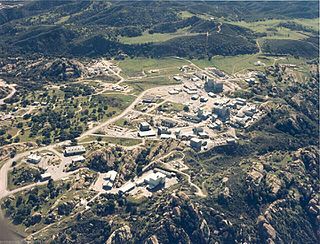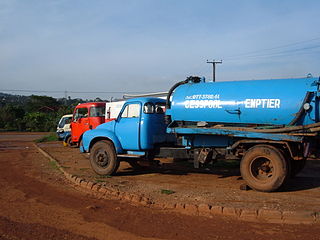
Hazardous waste is waste that has substantial or potential threats to public health or the environment. Hazardous waste is a type of dangerous goods. They usually have one or more of the following hazardous traits:ignitability, reactivity, corrosivity, toxicity. Listed hazardous wastes are materials specifically listed by regulatory authorities as hazardous wastes which are from non-specific sources, specific sources, or discarded chemical products. Hazardous wastes may be found in different physical states such as gaseous, liquids, or solids. A hazardous waste is a special type of waste because it cannot be disposed of by common means like other by-products of our everyday lives. Depending on the physical state of the waste, treatment and solidification processes might be required.

The Hanford Site is a decommissioned nuclear production complex operated by the United States federal government on the Columbia River in Benton County in the U.S. state of Washington. It has also been known as Site W and the Hanford Nuclear Reservation. Established in 1943 as part of the Manhattan Project, the site was home to the Hanford Engineer Works and B Reactor, the first full-scale plutonium production reactor in the world. Plutonium manufactured at the site was used in the first atomic bomb, which was tested in the Trinity nuclear test, and in the Fat Man bomb used in the bombing of Nagasaki.

Toxic waste is any unwanted material in all forms that can cause harm. Mostly generated by industry, consumer products like televisions, computers, and phones contain toxic chemicals that can pollute the air and contaminate soil and water. Disposing of such waste is a major public health issue.

The Waste Isolation Pilot Plant, or WIPP, is the world's third deep geological repository licensed to store transuranic radioactive waste for 10,000 years. The storage rooms at the WIPP are 2,150 feet underground in a salt formation of the Delaware Basin. The waste is from the research and production of United States nuclear weapons only. The plant started operation in 1999, and the project is estimated to cost $19 billion in total.

The Savannah River Site (SRS) is a U.S. Department of Energy (DOE) reservation in the United States in the state of South Carolina, located on land in Aiken, Allendale, and Barnwell counties adjacent to the Savannah River, 25 miles (40 km) southeast of Augusta, Georgia. The site was built during the 1950s to refine nuclear materials for deployment in nuclear weapons. It covers 310 square miles (800 km2) and employs more than 10,000 people.

Cesspit, cesspool and soak pit in some contexts are terms with various meanings: they are used to describe either an underground holding tank or a soak pit. A cesspit can be used for the temporary collection and storage of feces, excreta or fecal sludge as part of an on-site sanitation system and has some similarities with septic tanks or with soak pits. Traditionally, it was a deep cylindrical chamber dug into the ground, having approximate dimensions of 1 metre (3') diameter and 2–3 metres depth. Their appearance was similar to that of a hand-dug water well.
Onsite sewage facilities (OSSF), also called septic systems, are wastewater systems designed to treat and dispose of effluent on the same property that produces the wastewater, in areas not served by public sewage infrastructure.
GeoMelt is a process by which dangerous, contaminated material is mixed with clean soil, a blend of industrial minerals, and/or glass frit and melted to create an extremely hard and leach-resistant glass product. Vitrification immobilizes nearly all of the inorganic contaminants present in the initial mixture by incorporation into the glass matrix. Organic wastes in the melt are destroyed by pyrolysis, and gaseous contaminants released during the melting process are treated separately.

A grease trap is a plumbing device designed to intercept most greases and solids before they enter a wastewater disposal system. Common wastewater contains small amounts of oils which enter into septic tanks and treatment facilities to form a floating scum layer. This scum layer is very slowly digested and broken down by microorganisms in the anaerobic digestion process. Large amounts of oil from food preparation in restaurants can overwhelm a septic tank or treatment facility, causing the release of untreated sewage into the environment. High-viscosity fats and cooking grease such as lard solidify when cooled, and can combine with other disposed solids to block drain pipes.
Nuclear entombment is a method of nuclear decommissioning in which radioactive contaminants are encased in a structurally long-lived material, such as concrete. This prevents radioactive material and other contaminated substances from being exposed to human activity and the environment. Entombment is usually applied to nuclear reactors, but also some nuclear test sites. Nuclear entombment is the least used of three methods for decommissioning nuclear power plants, the others being dismantling and deferred dismantling. The use of nuclear entombment is more practical for larger nuclear power plants that are in need of both long and short term burials, as well as for power plants which seek to terminate their facility licenses. Entombment is used on a case by case basis because of its major commitment with years of surveillance and complexity until the radioactivity is no longer a major concern, permitting decommissioning and ultimate unrestricted release of the property. Considerations such as financial backing and the availability of technical know-how are also major factors.

Biomedical waste or hospital waste is any kind of waste containing infectious materials generated during the treatment of humans or animals as well as during research involving biologics. It may also include waste associated with the generation of biomedical waste that visually appears to be of medical or laboratory origin, as well research laboratory waste containing biomolecules or organisms that are mainly restricted from environmental release. As detailed below, discarded sharps are considered biomedical waste whether they are contaminated or not, due to the possibility of being contaminated with blood and their propensity to cause injury when not properly contained and disposed. Biomedical waste is a type of biowaste.

The Energy Technology Engineering Center (ETEC), was a government-owned, contractor-operated complex of industrial facilities located within the 2,850-acre (11.5 km2) Santa Susana Field Laboratory (SSFL), Ventura County, California. The ETEC specialized in non-nuclear testing of components which were designed to transfer heat from a nuclear reactor using liquid metals instead of water or gas. The center operated from 1966 to 1998. The ETEC site has been closed and is now undergoing building removal and environmental remediation by the U.S. Department of Energy.

Waste are unwanted or unusable materials. Waste is any substance discarded after primary use, or is worthless, defective and of no use. A by-product, by contrast is a joint product of relatively minor economic value. A waste product may become a by-product, joint product or resource through an invention that raises a waste product's value above zero.

A vacuum truck, vacuum tanker, vactor truck, vactor, vac-con truck, vac-con is a tank truck that has a pump and a tank. The pump is designed to pneumatically suck liquids, sludges, slurries, or the like from a location into the tank of the truck. The objective is to enable transport of the liquid material via road to another location. Vacuum trucks transport the collected material to a treatment or disposal site, for example a sewage treatment plant.

Municipal solid waste (MSW) – more commonly known as trash or garbage – consists of everyday items people use and then throw away, such as product packaging, grass clippings, furniture, clothing, bottles, food scraps and papers. In 2018, Americans generated about 292.4 million short tons (265.3 Mt) of trash. In the United States, landfills are regulated by the Environmental Protection Agency (EPA) and the states' environmental agencies. Municipal solid waste landfills (MSWLF) are required to be designed to protect the environment from contaminants that may be present in the solid waste stream.

Clean Harbors, Inc. is an American provider of environmental and industrial services, including hazardous waste disposal for companies, small waste generators and federal, state, provincial and local governments.
The Plutonium Finishing Plant (PFP), also known as 'Z Plant', was part of the Hanford Site nuclear research complex in Washington, US.
The former Operating Industries Inc. Landfill is a Superfund site located in Monterey Park, California at 900 N Potrero Grande Drive. From 1948 to 1984, the landfill accepted 30 million tons of solid municipal waste and 300 million US gallons (1,100,000 m3) of liquid chemicals. Accumulating over time, the chemical waste polluted the air, leached into groundwater, and posed a fire hazard, spurring severely critical public health complaints. Recognizing OII Landfill's heavy pollution, EPA placed the financial responsibility of the dump's clean-up on the main waste-contributing companies, winning hundreds of millions of dollars in settlements for the protection of human health and the environment.
Solid waste policy in the United States is aimed at developing and implementing proper mechanisms to effectively manage solid waste. For solid waste policy to be effective, inputs should come from stakeholders, including citizens, businesses, community-based organizations, non-governmental organizations, government agencies, universities, and other research organizations. These inputs form the basis of policy frameworks that influence solid waste management decisions. In the United States, the Environmental Protection Agency (EPA) regulates household, industrial, manufacturing, and commercial solid and hazardous wastes under the 1976 Resource Conservation and Recovery Act (RCRA). Effective solid waste management is a cooperative effort involving federal, state, regional, and local entities. Thus, the RCRA's Solid Waste program section D encourages the environmental departments of each state to develop comprehensive plans to manage nonhazardous industrial and municipal solid waste.
The A.O. Polymer manufacturing site is located in Sparta Township, New Jersey. This facility created special polymers, plastics, and resins. It was also used for reclaiming spent solvents. The facility's poor waste handling led to serious contamination of the ground. It also contaminated the water in the ground with volatile organic compounds. The site has been a threat to the Allentown aquifer, which provides drinking water to over 5,000 people. Initial clean ups started with getting rid of old drums and contaminants from their original disposal area. The company took them and decided to dispose of them elsewhere, thus not fixing the problem. Primary cleanups of the site were ongoing as of 2008. The EPA has been using water pumps to remove contaminants from the water in the ground. A soil extraction system has been put at their disposal to remove harmful contamination within the soil as well. All wells in the affected areas have been closed.












